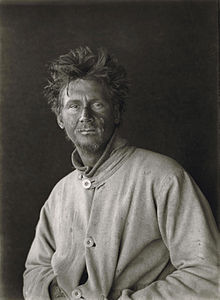Charles Seymour Wright

Sir Charles Seymour Wright , KCB , OBE , MC (born April 7, 1887 in Toronto , † November 1, 1975 in Saltspring Island , British Columbia , both Canada ), nicknamed "Silas" Wright after the writer Silas Hocking , was a Canadian physicist and member of the Terra Nova Expedition 1910–1913 of Robert Falcon Scott .
Life
Wright was born in Toronto in the Old Toronto, North End, Rosedale borough in 1887, the son of an insurance manager. He attended Upper Canada College , where he was also Head Boy (comparable to the Head Boy ) and particularly excelled in sports. As a teenager he went on exploratory trips by canoe to the unmapped northern Canada. He studied physics at the University of Toronto and won a scholarship for postgraduate studies at Gonville and Caius College , Cambridge , where he conducted research on cosmic rays at the Cavendish Laboratory from 1908 to 1910 . There he met Douglas Mawson , who had recently returned from Shackleton's British Antarctic Expedition 1907-1909 , the Nimrod Expedition . He found out about Scott's planned expedition to the South Pole and applied to participate, but was initially turned down. Not deterred by this, he wandered from Cambridge to London to introduce himself personally. This time Scott accepted the application and Wright was hired as a glaciologist and assistant physicist.
During the expedition, Wright conducted numerous experiments on ice formation and radiation on the surface, and assisted meteorologist George Clarke Simpson . From January 1911 to mid-March 1911 he was with the geologist Frank Debenham and the petty officer Edgar Evans part of the four-member Western Party led by Thomas Griffith Taylor , which covers the coastal area west of McMurdo Sound in a region between the McMurdo dry valleys and the Koettlitz Glacier explored and mapped.
Wright was a member of the Southern Party that broke up from base camp at Cape Evans in November 1911 . Wright hoped to belong to the Pole group. However, on December 22nd, shortly after the Upper Glacier Depot was set up , he was sent back as the second support group at 85 ° 15 ' with Navy doctor Edward Atkinson , zoologist Apsley Cherry-Garrard and boatswain Patrick Keohane . For the next five weeks he helped the group navigate the more than 900 km long way back to Cape Evans. There the group waited for Scott to return, which never happened. On November 12, 1912, it was Wright, as a member of the 11-person search party led by Atkinson, who first sighted the tent with the bodies of Scott, Edward Wilson and Henry Bowers .
On his return to England Wright married the sister of Raymond Priestley , another member of the expedition. He gave lectures in cartography and surveying and published his scientific work.
With the outbreak of World War I, he joined the Royal Engineers as a Second Lieutenant and served in France. During his World War I military career, he helped develop wireless communications in the trenches and received the Military Cross and the Order of the British Empire (OBE). In 1919 he joined the Admiralty Research Department . By 1929 he was Superintendent (officer rank without officer license) and from 1934 to 1936 he was Director of Scientific research over the Admiralty. During World War II he was involved in the early phase of the development of the Allied radar system and developed devices for detecting magnetic mines and torpedoes. For his contribution he was knighted in early 1946.
When the Royal Naval Scientific Service was founded in 1946, he was named the first Chief of the service . He then went to Washington, DC as a scientific advisor to the Admiral of the British Joint Services Mission . In 1951 he became director of the Marine Physical Laboratory of the Scripps Institution of Oceanography in La Jolla . In 1955 he became a member of the Defense Research Board of the Pacific Naval Laboratory in Canada and in 1967 of the Institute of Earth Sciences at the University of British Columbia and the Royal Roads Military College in Victoria , the capital of British Columbia.
Wright returned to Antarctica twice, in 1960 and 1965. In 1969 Wright retired to Saltspring Island , British Columbia, where he lived until his death at the age of 88.
Several geographic objects in Antarctica bear his name. Specifically, these are Wright Bay , the Upper and Lower Wright Glaciers, as well as the Wright Valley and Mount Wright .
Web links
- Publications by Sir Charles Seymour Wright
- The Remarkable Wright , Legion (Canadian military history magazine) article, 2005
Individual evidence
- ↑ Return to Antarctica ( Memento of the original from April 16, 2012 in the Internet Archive ) Info: The archive link was inserted automatically and has not yet been checked. Please check the original and archive link according to the instructions and then remove this notice.
- ↑ See Scott's instructions, Scott's Last Expedition. Vol. II, pp. 184/85.
- ↑ Apsley Cherry-Garrard: The Worst Journey in the World. 1965 edition, published by Penguin Travel Library, 1970, ISBN 0-14-009501-2 , p. 394.
| personal data | |
|---|---|
| SURNAME | Wright, Charles Seymour |
| ALTERNATIVE NAMES | Wright, Silas |
| BRIEF DESCRIPTION | Canadian physicist and polar explorer |
| DATE OF BIRTH | April 7, 1887 |
| PLACE OF BIRTH | Toronto , Ontario , Canada |
| DATE OF DEATH | 1st November 1975 |
| Place of death | Saltspring Island , British Columbia , Canada |